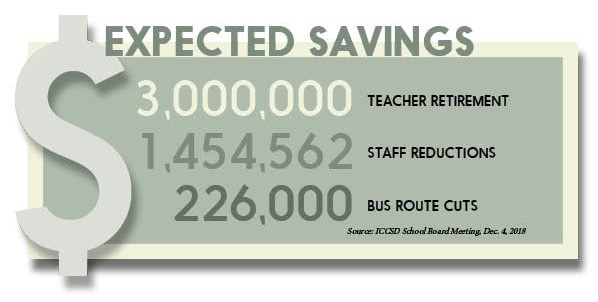Cut
Facing a $5-6 million budget cut for the upcoming school year, the district is planning to minimize the effect on students, although major changes are inevitable.
A lot can be done with $6 million. It can provide over 8,500 villages in underdeveloped countries with clean water, give over 700,000 children school supplies, purchase over 1.2 million drinks at Starbucks and even buy everything in your local Target.
Six million dollars is also something schools need to pay teachers, update classrooms and offer students the best education possible. Unfortunately, the ICCSD will need to function without it in the upcoming school year.
For the last eight out of nine years, Iowa has underfunded public education. While funding per student is increasing annually, it is not keeping pace with the inflation rates or the rising cost of operating schools.
Because of this, the district plans to cut around $6 million from their budget. The school board is continuing to look into where money can be cut, but there is one area where reductions in funding will be nearly unavoidable.
“Unfortunately, most of the choices involve staff, because about 84 percent of our budget goes to people,” said Superintendent Steve Murley.
Possible reductions in staff will mainly include administrator, teacher, secretary and custodian positions. Even though the decrease in teaching staff will be kept as minimal as possible, it will make a difference to students, as fewer teachers will lead to larger class sizes. According to Murley, as a last resort, “reductions in force” will occur, meaning employees will be laid off.
However, Murley is optimistic that this increase will not be noticeable at the high school level.
“The average [class size district wide] this year was around 24.2, and the average next year might be 24.8. So depending on the class you’re in, you might or might not see it in terms of the increasing class size,” Murley said. “Where kids will notice a difference or their parents will is more likely at the elementary level, because they’re in the same class all day. As those creep up a little bit, people will see that.”
Even though Murley is confident that students will not notice a considerable increase in class size, teachers at West are not so sure that this change will go unnoticed.
“Teachers have been feeling that pressure for a while. We’re used to 35 students in our rooms,” said Megan Johnson, social studies teacher and executive board member of the Iowa City Education Association. “I feel like once it gets to that point where you have 35 students in your room, even just adding a few more can make a big difference in a teacher’s ability to meet the one-on-one needs of students.”
A natural turnover occurs each year in all staff positions, and while these jobs would normally be filled, the district has implemented a hiring freeze this year, resulting in all vacant jobs left unfilled. This, along with the enhanced Early Retirement Program, is designed to help save money. With the upgraded retirement program, staff who choose to retire this year will receive more benefits than in years past.

Because staff members’ salaries increase the longer they have been in the district, it takes an unproportional chunk out of the budget when there are many senior members on staff. Therefore, the district is aiming to save money by incentivizing early retirement for eligible employees.
“We made it a little bit more attractive for people who might be on the edge and hopefully provide enough of an incentive for them to choose to do that,” Murley said. “It’s kind of a catch-22 for us: we lose a lot of experience and some really wonderful teachers who choose to take that option. But the benefit is that we’re able to retain or hire younger teachers whose cost to the budget is less.”
The district fell short of their goal of 75 retirees, with 41 staff members requesting retirement as of Jan. 31. However, it is likely they will get closer to the desired number after taking into consideration other staff transitions, which occur for reasons such as a spouse getting a job elsewhere or a move.
Because the Early Retirement Program included benefits like health insurance, eligible staff who had not previously considered retirement were faced with a tempting choice.
“I had no plans on retiring this spring until the board offered a once-in-a-lifetime incentive package for early retirement,” said health teacher Kathy Bresnahan. “To have a full salary next year was nice but having health insurance until Medicare kicks in was too good to pass up. It was unprecedented.”
Bresnahan had planned on teaching for at least another three years before she was informed about the benefits of the new program. She, along with the 128 other eligible staff members throughout the district, found themselves facing the same dilemma.
From an outside perspective, the situation may seem less than ideal. However, as unfortunate as it is, the district would be facing exponentially worse changes if action were not taken.
“As much as I wish that this didn’t have to happen, legally, if the district didn’t do something about it now, we would be in a situation in a year or two where we would be running a negative balance,” Johnson said. “And then what happens is the state basically comes in and the school district no longer gets to decide where they’re going to cut money. The state just says, ‘You’re cutting here, and you’re cutting here.’”
By making budget cuts now, course offerings and extracurriculars within the schools are better protected. Aside from the annual process where courses are offered based on student interest, no other cuts are intended to take place. This is a relief to students and teachers who witnessed the elimination of the German language program in the last major budget cut. Yet, while the intention to keep all classes may look good on paper, there are still doubts that it will work out as planned.
“I’ve always found it really valuable that West High has such diverse course offerings and there’s something for everyone. So I worry about the experiences that we’re going to be able to provide students in a world in which we don’t have the money to provide them,” Johnson said.
With many uncertainties surrounding the issue of the upcoming budget cut, nobody really knows what to expect. Even when the budget is finalized by April 15, it will be difficult to predict what kind of environment students and teachers will be living in during the upcoming school year. Whatever the end result may be, Johnson believes it is important to keep in mind that delayed action may have resulted in a more serious outcome down the road.
“As [bad] as the situation is,” Johnson said. “I’m glad that our school district is being proactive about it and is being collaborative with teachers and trying to figure out how to best deal with it.”
Your donation will support the student journalists of West High School. Your contribution will allow us to purchase Scholarship Yearbooks, newsroom equipment and cover our annual website hosting costs.

Natalie Katz is a senior at West High. This is her third year on staff and she is the print editor-in-chief and an online reporter. In her free time, she...

Amy Liao, a senior at West, is a third-year staffer and returning design editor for newspaper. She is looking forward to another year of Making Things...




